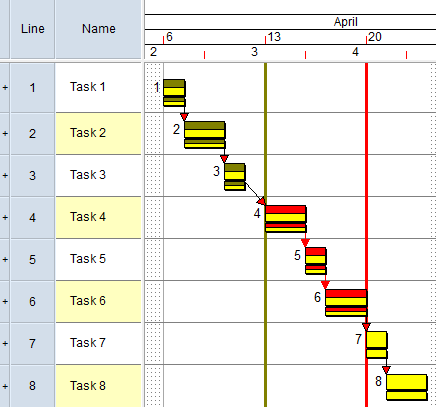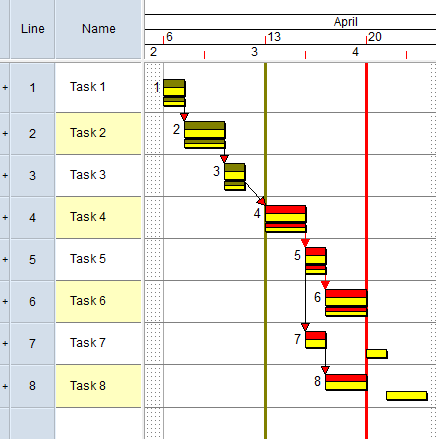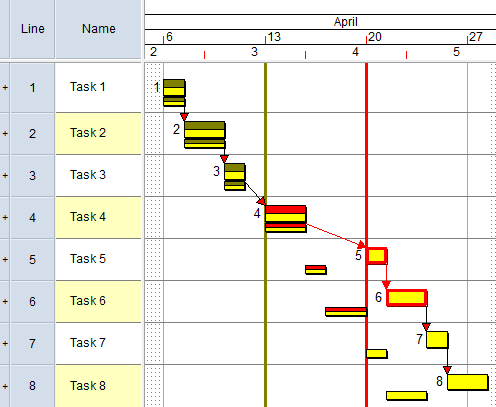'Baseline execution index' quality metric
Use the 'Baseline execution index' metric to check whether a schedule is proceeding according to plan. This metric divides the number of tasks in the live data that are completed by the progress entry period report date, by the number of tasks in the current baseline that are completed by the same date - ie the number of tasks that should have been completed - to determine the ratio between these values. A ratio less than 1 can indicate that a schedule is not proceeding according to plan, although you should allow some leeway as live tasks that have been completed may not appear as complete in a schedule immediately, depending on how often progress is updated.
Number of tasks in live data completed by progress entry period report date / Number tasks in current baseline completed by progress entry period report date = Baseline execution index
This metric meets the requirements of DCMA test 14 (Baseline execution index (BEI)).
In the following illustration, exactly the same number of tasks in the live data - six - have been completed by the report date of the progress entry period as have been completed in the current baseline (the baseline tasks are shown immediately beneath the corresponding tasks in the live data):

In this project, the baseline execution index is 1.00 (6 / 6 = 1). The schedule is proceeding according to plan. With the pass boundary set to 1.00 and the fail boundary set to 0.95, the project would pass this metric.
In the following illustration, eight tasks in the live data have been completed by the report date of the progress entry period, and six have been completed in the current baseline:

In this project, the baseline execution index is 1.33 (8 / 6 = 1.33). The schedule is proceeding more quickly than planned. With the pass boundary set to 1.00 and the fail boundary set to 0.95, the project would pass this metric.
In the following illustration, four tasks in the live data have been completed by the report date of the progress entry period, and six have been completed in the current baseline:

In this project, the baseline execution index is 0.67 (5 / 6 = 0.67). The schedule is proceeding more slowly than planned. With the pass boundary set to 1.00 and the fail boundary set to 0.95, the project would fail this metric.
You can change the impact that this metric has on the weighted total result of a quality check by entering a factor by which the quality metric should be multiplied in the Weighting field. For the weighting to have any effect, a quality check must have more than one quality metric.
As this metric results in a ratio rather than a percentage (where any ratio greater than 1 is a desirable result), the ratio is turned into a percentage for weighting purposes by multiplying it by 100; any resulting percentages greater than 100% are reduced to 100%. The resulting percentage is multiplied by the weighting factor you specify.
Pass and fail criteria
| Pass or fail? | Criteria |
|---|---|
| Pass |
A project passes this metric if the ratio of the number of tasks in the live data that are completed by the progress entry period report date to the number of tasks in the current baseline that are completed by the same date is greater than or equal to the pass boundary.
For example, if the pass boundary was set to 1.00, a project would pass this metric if the ratio was 1.00 or greater. |
| Fail |
A project fails this metric if the ratio is less than the fail boundary.
For example, if the fail boundary was set to 0.95, a project would fail this metric if the ratio was less than 0.95. |
| Neither pass nor fail | If the ratio falls between the pass and fail boundary, the result is neither a pass nor a fail, but somewhere in between. |
Suggested settings to meet the requirements of DCMA test 14 (Baseline execution index (BEI))
- Pass boundary: 1.00. A project will pass this metric if the baseline execution index is 1.00 or greater.
- Fail boundary: 0.95. A project will fail this metric if the baseline execution index is less than 0.95.
The following table shows whether some example projects would pass or fail this metric using these settings:
| Baseline execution index | Pass or fail? |
|---|---|
| 0.00 | Fail |
| 0.50 | Fail |
| 0.94 | Fail |
| 0.95 | Neither pass nor fail |
| 0.99 | Neither pass nor fail |
| 1.00 | Pass |
| 2.00 | Pass |
Does the metric force a project to be rescheduled?
No.
Suggested actions if a project fails this metric
You could take the following actions if a project fails this metric:
- Review the tasks in the live data to determine whether there is any way of shortening the project.
- Review the current baseline to determine whether the planned schedule is realistic.